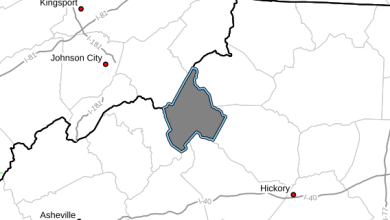Last Updated on August 2, 2018 9:36 am
***Editor's Note – In August 2015 WataugaOnline.com, then WataugaRoads.com, published an article noting 75 Years Apart – 1940s Flood Anniversary Noted, Downtown Boone Aug 1940/Downtown Boone Aug 2015. Click on the link for more information.***
*Town of Boone Press Release*
On Monday, August 13, 2018, at 5:30pm, the Town of Boone, in conjunction with the Boone Historic Preservation Commission, will unveil a new historical marker highlighting the effects of the devastating 1940 flood on Boone and Watauga County. The marker will be located in Jimmy Smith Park, adjacent to Rivers Street and near the site of the former Linville River Railway Depot at Boone.
Established in 1918, the Linville River Railway extension to Boone was the culmination of 15 years of efforts by B. B. Dougherty and other prominent Boone citizens. Freight service began in December 1918, followed quickly by mail service and passenger service in early 1919. The line extended from Boone to Cranberry, North Carolina, where it connected with the East Tennessee & Western North Carolina Railroad, better known locally as “Tweetsie.”
Completion of the rail line to Boone entirely transformed the sleepy county seat into a bustling commercial center. Rail access meant that business owners could easily transport brick, lumber, and steel to the heart of downtown Boone—a virtual impossibility before 1919, given the poor quality of roads in the county. As a result, Boone saw a commercial and residential building boom, with many of the current downtown buildings completed between 1920 and 1940, particularly along King Street.
Passenger service, however, was always a bit spotty, in large part because of low demand. The Great Depression didn’t help either, and by the 1930s, the rail line was struggling. Other than occasional special excursions, passenger traffic had nearly ceased by 1940, and freight traffic was greatly reduced on the line, in large part because of rapidly improving roads in the county.

August 13, 1940. Photograph by Paul Weston, courtesy of Rejean Young and the
Digital Watauga Project (Paul and Ruby Weston Collection).
The death knell for the Linville River Railway, however, came in 1940, when a large hurricane began spreading heavy rain over western North Carolina on August 10. After moving inland, the storm stalled over the mountains on August 13. By that evening, more than 14 inches of rain had fallen in many places in the county, prompting more than 2,000 landslides. All told, the storm claimed at least 16 lives in Watauga County. Damage from the landslides also claimed much of the Linville River Railway track between Cranberry to Boone, with infrastructure losses so severe that the line to Boone was never rebuilt. The old depot was eventually moved out of Rivers Street, then ultimately demolished in 1976.
The new marker is intended to draw public attention to this pivotal moment in Boone’s and Watauga County’s history. Mayor Brantz and representatives from the Boone Town Council and the Boone Historic Preservation Commission are expected to be on hand for the unveiling of the marker. The unveiling ceremony at Jimmy Smith Park is free and open to the public.
In addition to the marker unveiling, the Town of Boone will also be sponsoring a Lunch and Learn event hosted by the Boone Area Chamber of Commerce at the Hampton Inn at 11:30am on Wednesday, August 8. Dr. Eric Plaag, the chairperson of the Boone Historic Preservation Commission and the chairperson of the Digital Watauga Project, will be sharing images from the 1940 Flood and presenting his talk “Literally Washed Away.” Focusing on the flood’s effects on Downtown Boone, Dr. Plaag will discuss why the flood was so devastating and what we can still learn from this tragic event.
To reserve your seat for the Lunch and Learn, contact Wysteria White at the Boone Area Chamber of Commerce (wysteria@boonechamber.com or 828-264-2225). Tickets are $10 for members and $15 for non-members. Tickets can also be reserved through the Boone Chamber’s events calendar at http://boonechamber.com.

















